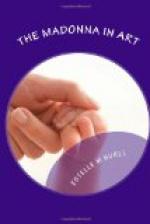The crown is essentially Teutonic in origin and character. Turning to the representative art of Germany and Belgium, we find the Virgin almost invariably wearing a crown, whether she sits on a throne, or in a pastoral environment. No better example could be named than the celebrated Holbein Madonna, of Darmstadt, known chiefly through the copy in the Dresden Gallery. Here the imposing height of the Virgin is rendered still more impressive by a high, golden crown, richly embossed and edged with pearls. Beneath this her blond hair falls loosely over her beautiful neck, and gleams on the blue garment hanging over her shoulders. Strong and tender, this noble figure sums up the finest elements in the Madonna art of the North.
A simple and lovely form for the Madonna’s crown is the narrow golden fillet set with pearls, singly or in clusters. This is placed over the Virgin’s brow just at the edge of the hair, which is otherwise unconfined. This is seen on Madonnas by Van Eyck (Frankfort), Duerer (woodcut of 1513), Memling (Bruges), Schongauer (Munich).
[Illustration: QUENTIN MASSYS.—MADONNA AND CHILD.]
In the enthroned Madonna by Quentin Massys, in the Berlin Gallery, we have many typical characteristics of Northern art. The throne itself is exceedingly rich, ornamented with agate pillars with embossed capitals of gold. The Virgin has the fine features and earnest, tender expression which recalls earlier Flemish painters. Her dress falls in rich, heavy folds upon the marble pavement. But, as with Van Eyck and Memling, Holbein and Schongauer, fine clothes do not conceal her girlish simplicity or her loving heart. A low table, spread with food, stands at the left,—a curious domestic element to introduce, and thoroughly Northern in realism.
Considered as a symbol of the exaltation of motherhood, there is no reason why the throne should go out of fashion; but if it is to appear, it must be used intelligently, and with some adaptation to present modes of thought, not servilely imitated from the forms of a by-gone age. This is a fact too little appreciated by the artists of to-day. Many modern pictures could be cited—by Bouguereau, Ittenbach, and others—of enthroned Madonnas in which is adopted the form, but not the spirit, of the Italian Rennaissance. In such works, the setting is a mere affectation entirely out of taste. If we are to have a throne, let us have a Madonna who is a veritable queen.
CHAPTER III.
THE MADONNA IN THE SKY.
(THE MADONNA IN GLORIA.)
We have seen that the first Madonnas were painted against a background either of solid gold, or of cherub figures, and that the latter style of setting was continued in the early pictures of the enthroned Madonna. The effect was to idealize the subject, and carry it into the region of the heavenly. This was the germinal idea which grew into the “Madonna in Gloria.”




